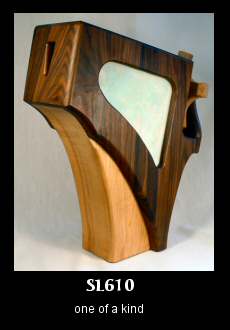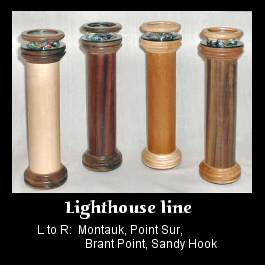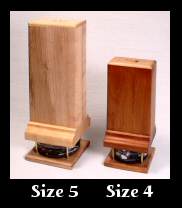 A
discussion of some kaleidoscope topics. And from the museum archives, pictures
of earlier kaleidoscopes by A.W. Scopes.
A
discussion of some kaleidoscope topics. And from the museum archives, pictures
of earlier kaleidoscopes by A.W. Scopes.
OBJECT CASES.
The object case (also called object cell or chamber) is at the end of the scope opposite the eyehole
and holds the various objects that will make up the image of the scope. It is usually rotated
to create virtually endless variations of the image.
Unless otherwise specified, all of my object cases are liquid-filled.
The viscosity of the liquid is such that the objects will move slowly and quietly into place when
the object case is turned.
LIGHTING the objects.
Good light shining into the object case is important for
optimum viewing. This is especially important with a "side-lit" object case; that is, there is an
opaque back to the case, and the objects are lit with light entering from the side. Most of my
scope designs have a side-lit object case with a dramatic black background. Viewing outdoors or
by a sunny window can provide good light. Hold your scope under a lamp, and watch the details
and colors come alive.
LAMPWORKED GLASS.
Almost any object is suitable for viewing through a kaleidoscope! Lampworked glass is very
desirable to contribute to beautiful images.
Lampworked glass is glass that is heated from the flame of a torch,
or "lamp", used for glass working, until it softens and can be shaped.
 The photo here displays an assortment of "twisties" that I like to make.
Two or more glass rods are heated and twisted together
to form the patterns. I use pieces from canes like these for much of the lampworked glass
that is found in all of my object cases.
The photo here displays an assortment of "twisties" that I like to make.
Two or more glass rods are heated and twisted together
to form the patterns. I use pieces from canes like these for much of the lampworked glass
that is found in all of my object cases.
MIRROR SYSTEMS. The most common mirror system configurations have three
sides. That is, three long rectangular pieces joined together at specific angles to form a
triangular tube with the mirrors facing in towards each other. This tube is secured
inside the body of the scope and extends from the eyehole
to the object case at the other end. We look through the eyehole and this mirror tube to see the
objects which are reflected in various ways, depending on the mirror setup,
to create the seemingly magical views inside the kaleidoscope.

All three sides can be mirrors or there can be two mirrors
and a black or non-reflective side. With three mirrors, reflected images are propagated in all
directions filling the entire
field of view, like wallpaper as far as you can see in any direction. With two mirrors,
reflected images continue around to form a centered circular image (surrounded by black
from the third side).
This round-like image is the mandala generated by a kaleidoscope. You may hear something like an
image is a six-point mandala or star. The number of points of the image depends on the
angle formed by the two
mirrors at its opening. Now...it takes 2 adjacent reflections to form a "point", so there
are actually 12 separate image sections forming a whole six-point image. Each of the 12 sections
-- the original view through to the objects and 11 reflections of it around the circle --
are the shape of the opening of the mirrors.
 Since there are 360° in a circle,
the mirrors for a six-point star are assembled at an angle of 30°
(360° / 12 images = 30° each). If it were slightly more or
less than 30°, there would be slightly more or less
than 12 images and there wouldn't be exactly six points. A 6.1 or 5.9 point image would disrupt the
symmetry of the mandala, so it is important that the angle be right on.
Since there are 360° in a circle,
the mirrors for a six-point star are assembled at an angle of 30°
(360° / 12 images = 30° each). If it were slightly more or
less than 30°, there would be slightly more or less
than 12 images and there wouldn't be exactly six points. A 6.1 or 5.9 point image would disrupt the
symmetry of the mandala, so it is important that the angle be right on.
Or think of a pie divided into, let's say, 18 equal slices (or images). (If you didn't like
geometry, skip this paragraph.)
There is a 20° angle (360/18) at the pie center for each slice.
So a nine point mandala image (2 "slices" per "point")
would have mirrors assembled at 20°. (Or think of it as 180 / # of points; i.e. 180 / 9 = 20)
How about a 5-point image? ...36° (360/10 or 180/5). An 8-point image is 22.5°.
Um...how many points from a 12° angle?...15 points. Very good.
How about an 11 pointer? WHOA, this is becoming way too much fun (I liked geometry). If you didn't bother
to follow this, I assure you it will have no effect on your enjoyment of the scopes.
 Other mirror systems may have 4 mirrors, or the mirrors can be "tapered" (shaped more like a
trapezoid than a rectangle), or curved at the end, or... All of the variations affect
the shape and character of the image.
Kaleidoscope artists are frequently experimenting with mirrors to create new and exciting views.
Other mirror systems may have 4 mirrors, or the mirrors can be "tapered" (shaped more like a
trapezoid than a rectangle), or curved at the end, or... All of the variations affect
the shape and character of the image.
Kaleidoscope artists are frequently experimenting with mirrors to create new and exciting views.
MIRRORS. Front or first-surface mirrors have their
reflective coating on the front surface of the glass. Ordinary mirrors have the coating
on the back and is protected by the glass which we look through to see our reflection.
A regular mirror, with its two reflections -- one from the surface and one from the image in the back
refracted as the light rays pass the glass-air interface -- degrades the clarity of a
kaleidoscope image.
Front-surface mirrors, with one reflection of light off its surface, generate a sharper image and
are essential for all high quality kaleidoscopes. They are used in all of the scopes you
will find here.
DIRECTION of MOVEMENT of objects. Besides the wonderful colors and shapes that
form a kaleidoscope image, I am also into the movement of the objects as they create the new image.
 Consider a two mirror system.
The edges where the mirrors meet form a point. The teardrop-like shape of the eyehole
of many of the scopes here, is aligned with this point and the "V" shaped opening formed
by the mirrors.
That is, the narrower side of the eyehole points in the same direction as the mirrors inside.
If you hold your scope so that the mirrors and eyehole
point down, you will notice that the objects in the image converge toward the center.
Now rotate the scope so that the mirrors point up; the
objects flower out from the middle toward the outside of the image.
If you hold the scope with the eyehole
near horizontal, the objects tend to move around the image as you turn the chamber. Changing
the position you are holding the scope and watching the objects move in or out or around, as
well as turning the object case quickly, slowly, or just a little bit at a time, or rotating
the whole scope, all
contribute to more variety during your kaleidoscope viewing session.
Consider a two mirror system.
The edges where the mirrors meet form a point. The teardrop-like shape of the eyehole
of many of the scopes here, is aligned with this point and the "V" shaped opening formed
by the mirrors.
That is, the narrower side of the eyehole points in the same direction as the mirrors inside.
If you hold your scope so that the mirrors and eyehole
point down, you will notice that the objects in the image converge toward the center.
Now rotate the scope so that the mirrors point up; the
objects flower out from the middle toward the outside of the image.
If you hold the scope with the eyehole
near horizontal, the objects tend to move around the image as you turn the chamber. Changing
the position you are holding the scope and watching the objects move in or out or around, as
well as turning the object case quickly, slowly, or just a little bit at a time, or rotating
the whole scope, all
contribute to more variety during your kaleidoscope viewing session.

EYEHOLE. If you view the image through the narrower end of the teardrop
shaped eyehole, you will be
looking down closer to the center of the image. If you view through the wider section of the
hole, you will see the center at a slight angle, for a subtle shift in the symmetry
of the image.
LENS. With most of the kaleidoscopes here, you are looking through
a glass optical lens
selected with the appropriate focal length for the scope. The lens magnifies the image and allows
for a more focused and detailed view of the objects. A magnifying lens may not be appropriate for
some mirror configurations or those scopes with a very large viewport.
SOMETIMES we listen to music, in the background,
while we are doing something else; and it's very nice.
But when you stop doing that something else, and take time to just sit between the speakers and
listen, that's when there is the greatest potential to absorb emotion from your favorite tunes
for truly satisfying moments. Similarly, sometimes you may pick up your kaleidoscope for a short while;
take a deep breath and smile; and it's very nice. And then when you take time out to sit
comfortably and view inside your scope for awhile with the proper lighting, it can be
relaxing, exhilarating, and also truly satisfying.
I hope you found this "kaleido-talk" page worth your while. I attempted to cover topics and
questions I have been frequently asked. I am here if you wish to discuss
anything further.
|